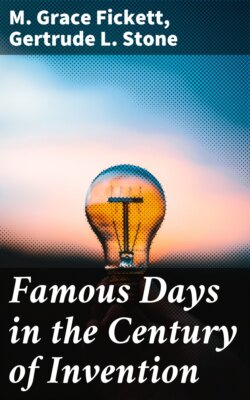Читать книгу Famous Days in the Century of Invention - M. Grace Fickett - Страница 6
На сайте Литреса книга снята с продажи.
PART III
ОглавлениеTable of Contents
Not many days after Jonathan's return, the first letter he ever received his father brought him from the post office. It hardly needed the post mark, Cambridge, to make Jonathan sure who had sent it. Let us open it with him:—
Cambridge, August 26, 1849.
My dear friend Jonathan,
Your letter with its inclosure of five dollars has been gratefully received. I remember you and your uncle, your father and your mother, with much pleasure. Ever since I ran that race in Boston I have been sure that the machine would work its way to success.
I am more confident now than ever. I have found some one who will buy out Mr. Fisher's interest; Mr. Burlingame will bring my old machine and letters patent from London; and every lawyer I have consulted says my claims are valid and I shall win my suit.
When I have succeeded, and the manufacture of sewing machines is under my control, I shall send for you to pick out a machine for your mother.
Again thanking you for your substantial interest, I am
Very faithfully yours,
Elias Howe, Jr.
This was in 1849. Mr. Howe's darkest days were over; but even then success came slowly and in rather a strange way. Mr. Howe's chief enemy was a Mr. Singer, who built machines and advertised them with remarkable success.
"You are infringing my patent," wrote Howe to Singer, upon hearing of the latter's activity.
"But you are not the inventor," replied Singer. "The Chinese have had a sewing machine for ages; an Englishman made one in 1790; a Frenchman built one in 1830; and what is more to the point, in 1832, a man named Walter Hunt, living in New York, invented a sewing machine with a shuttle stitch like yours. I can find Walter Hunt and prove my statement."
Well, Mr. Singer did find Walter Hunt and the fragments of his old machine. But "not all the king's horses nor all the king's men" could put those fragments together again so that the machine would sew. For four years, however, the trial in the courts continued. But at last, in 1854, when Mr. Howe had waited nine years after completing his first machine, the Wheelers and many others read with great satisfaction in the Worcester Spy:
"Judge Sprague of Massachusetts has decided that the plaintiff's patent is valid and that the defendant's machine is an infringement. Further, there is no evidence in this case that leaves a shadow of a doubt that, for all the benefit conferred upon the public by the introduction of a sewing machine, the public are indebted to Mr. Howe."
In 1855, Jonathan, now grown into a tall, manly youth of twenty, started with Uncle William on another journey, longer and more interesting than either had ever taken before. This time they went to New York, where they found Mr. Howe at the head of a prosperous business; and when they returned, they brought with them a Howe sewing machine of the very latest model, "a present from the inventor to Mrs. Wheeler, in gratitude for the sympathy and encouragement of her family."
